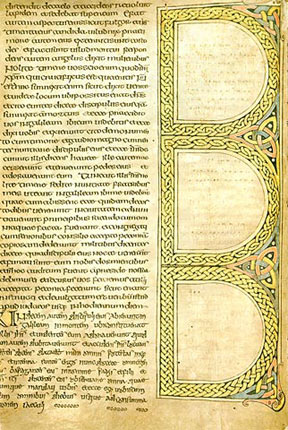Northumbria
Northumbria was a kingdom located in what is now Northern England and southeastern Scotland. From the 7th to the 10th centuries, it was one of the major Anglo-Saxon kingdoms, playing a significant role in the history and culture of Medieval England. Northumbria's history is marked by its contributions to Christianity, learning, and the arts, most notably through the production of illuminated manuscripts such as the Lindisfarne Gospels.
History[edit | edit source]
Northumbria's origins can be traced back to the early 7th century, following the unification of two earlier kingdoms, Bernicia and Deira. The kingdom's first ruler of note was King Edwin, who converted to Christianity under the influence of Paulinus of York, a missionary sent by Pope Gregory the Great. Following Edwin's reign, Northumbria became a center of religious activity and scholarship, particularly under King Oswald and his successor, Oswiu. The kingdom's prominence in ecclesiastical matters was further solidified with the Synod of Whitby in 664, which saw Northumbria adopt Roman rather than Celtic Christian practices.
During the 8th century, Northumbria experienced a golden age of culture and learning, often referred to as the Northumbrian Renaissance. This period was characterized by significant achievements in art, literature, and scholarship, with the Monastery of Lindisfarne and the Monastery of Jarrow being key centers of intellectual activity. The most famous product of this era is the Lindisfarne Gospels, an illuminated manuscript that is a masterpiece of Insular art.
However, the late 8th century saw the beginning of Viking raids on Northumbria, which eventually led to the kingdom's decline. In 867, Northumbria fell to the Vikings, becoming part of the Danelaw. Despite this, the region continued to be a significant cultural and religious center, with the Archbishopric of York playing a pivotal role in the church of the British Isles.
Geography[edit | edit source]
Northumbria's territory extended from the River Humber in the south to the River Forth in Scotland in the north, encompassing modern-day Northern England and parts of southeastern Scotland. Its landscape was diverse, featuring coastal plains, upland regions, and significant rivers such as the Tyne and the Tees, which were crucial for trade and communication.
Legacy[edit | edit source]
The legacy of Northumbria is evident in its lasting contributions to English culture, language, and religion. The kingdom played a crucial role in the spread of Christianity throughout England and the development of English art and scholarship. Many of Northumbria's historical sites, such as the ruins of the Lindisfarne Monastery and the Jarrow Hall, remain important cultural landmarks. Additionally, the stories and achievements of Northumbrian figures continue to inspire works of literature and art.
Search WikiMD
Ad.Tired of being Overweight? Try W8MD's physician weight loss program.
Semaglutide (Ozempic / Wegovy and Tirzepatide (Mounjaro / Zepbound) available.
Advertise on WikiMD
|
WikiMD's Wellness Encyclopedia |
| Let Food Be Thy Medicine Medicine Thy Food - Hippocrates |
Translate this page: - East Asian
中文,
日本,
한국어,
South Asian
हिन्दी,
தமிழ்,
తెలుగు,
Urdu,
ಕನ್ನಡ,
Southeast Asian
Indonesian,
Vietnamese,
Thai,
မြန်မာဘာသာ,
বাংলা
European
español,
Deutsch,
français,
Greek,
português do Brasil,
polski,
română,
русский,
Nederlands,
norsk,
svenska,
suomi,
Italian
Middle Eastern & African
عربى,
Turkish,
Persian,
Hebrew,
Afrikaans,
isiZulu,
Kiswahili,
Other
Bulgarian,
Hungarian,
Czech,
Swedish,
മലയാളം,
मराठी,
ਪੰਜਾਬੀ,
ગુજરાતી,
Portuguese,
Ukrainian
Medical Disclaimer: WikiMD is not a substitute for professional medical advice. The information on WikiMD is provided as an information resource only, may be incorrect, outdated or misleading, and is not to be used or relied on for any diagnostic or treatment purposes. Please consult your health care provider before making any healthcare decisions or for guidance about a specific medical condition. WikiMD expressly disclaims responsibility, and shall have no liability, for any damages, loss, injury, or liability whatsoever suffered as a result of your reliance on the information contained in this site. By visiting this site you agree to the foregoing terms and conditions, which may from time to time be changed or supplemented by WikiMD. If you do not agree to the foregoing terms and conditions, you should not enter or use this site. See full disclaimer.
Credits:Most images are courtesy of Wikimedia commons, and templates, categories Wikipedia, licensed under CC BY SA or similar.
Contributors: Prab R. Tumpati, MD






